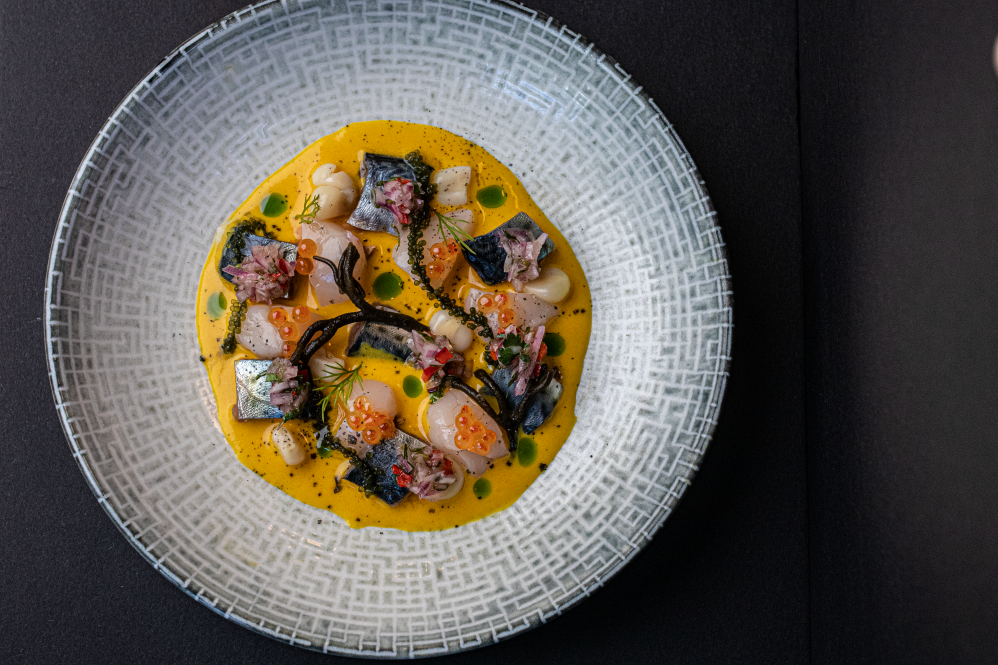The work Warike (or warique) has two meanings in Quecha — an indigenous language spoken in Peru — when broken apart. ‘Wa’ translates to unknown or hidden and ‘rique’ means stew.
Hector Chunga, Luis Guzman and Valeria Finogeeva thought it was a fitting name for a restaurant, which is fittingly tucked away on Devonshire Street in Sydney’s Surry Hills.
Warike launched earlier this year and has become known for its menu that lists regional dishes based on Chunga’s Peruvian roots and his career-defining experiences in the kitchen. The chef talks to Hospitality about the complexity of Peruvian food, utilising different chilli varieties and elevating traditional recipes.
Hector Chunga’s mission has always been to promote Peruvian cuisine overseas. After training and working in restaurants in Peru, the chef moved to Japan where he cooked for high-ranking officials at the Embassy of the Republic of Peru, honing his skills in both Japanese and Peruvian cooking techniques.
Chunga made the move to Australia to open Warike, a restaurant that aims to showcase regional Peruvian food. “There are seven regions in Peru,” says Chunga. “Every city and small town have different kinds of food [cooked] with different techniques and produce.”

Warike’s menu covers dishes from the Central Andes to the coast. While it is all-encompassing, a common thread is the use of Peruvian chillies, which are integral to traditional dishes. There are at least 50 varieties of chilli peppers grown in Peru, each with varying spice levels, colours and flavours.
The kitchen team uses ají amarillo, ají panca, ají limon and rocoto for different cooking applications. Using Peruvian chillies allows Chunga to create contemporary dishes with an underlying element of authenticity. “We try to use all the chillies we have to create new recipes, but we like to keep the Peruvian flavour,” he says.
While ají amarillo and ají limon provide brightness to dishes, ají panca has a smokier flavour that is ideal for slow-cooking and charcoal grilling. Rocoto is perhaps the spiciest chilli at the restaurant and is strictly used in smaller amounts. “Rocoto looks like a capsicum, but it’s very spicy,” says Chunga. “You have to work very carefully.”
Chunga has a knack for seafood dishes, notably from his hometown of Piura in northern Peru. “We have really beautiful beaches in Piura,” says Chunga. “We have really good seafood and fish, so most of the recipes are [fish-based].”
Tiraditos (Peruvian raw fish dishes) and ceviche are a specialty at Warike and are not only reflective of the chef’s childhood, but his love for Nikkei cuisine. “We use Japanese techniques to cut the fish and make a crudo,” says Chunga. “We also use Japanese pickles to mix with the proteins.”
An example is conchas y caballa, which sees blue mackerel and Hokkaido scallops coated in a smoked rocoto sauce and topped with Japanese salmon roe, dill and chalaquia, a mixture of onion, chilli, coriander and lime. The dish is a riff on a traditional mackerel ceviche, but Chunga has turned it into a tiraditos-style menu item.
“I try to mix the ingredients with more sophisticated products such as Hokkaido scallops and roe to make a tiraditos,” says Chunga. “The flavour reminds me of my
childhood, but it’s presented differently, and I use different techniques.”
While the restaurant has a selection of Nikkei-inspired dishes, it also delves into Chifa, a fusion of Chinese and Peruvian cuisines. Lomo saltado is an example; a stir fry-esque dish made with vegetables and beef accompanied by deep-fried potato chips. “The dish has a lot of Chinese influence,” says Chunga.
“We cook scotch fillet on charcoal with a lomo saltado sauce that includes yellow chilli pepper, cherry vinegar, soy sauce and oyster sauce.”
Warike is a restaurant that delivers a cultural representation of Peruvian cuisine. While dishes maintain the integrity of traditional flavours, Chunga uses his culinary skills to educate diners on the progressive nature of Peru’s foodscape.
Sponsored Content

Tru-Pour barware – accuracy made easy
Sponsored by Tomkin

Summer insurance essentials for mobile food truck owners
Sponsored by BizCover
Trending Now
Resources
Lorem ipsum dolor sit amet, consectetur adipiscing elit. Fusce ac ornare lectus. Sed bibendum lobortis...
Lorem ipsum dolor sit amet, consectetur adipiscing elit. Fusce ac ornare lectus. Sed bibendum lobortis...
Sign up for our newsletter
